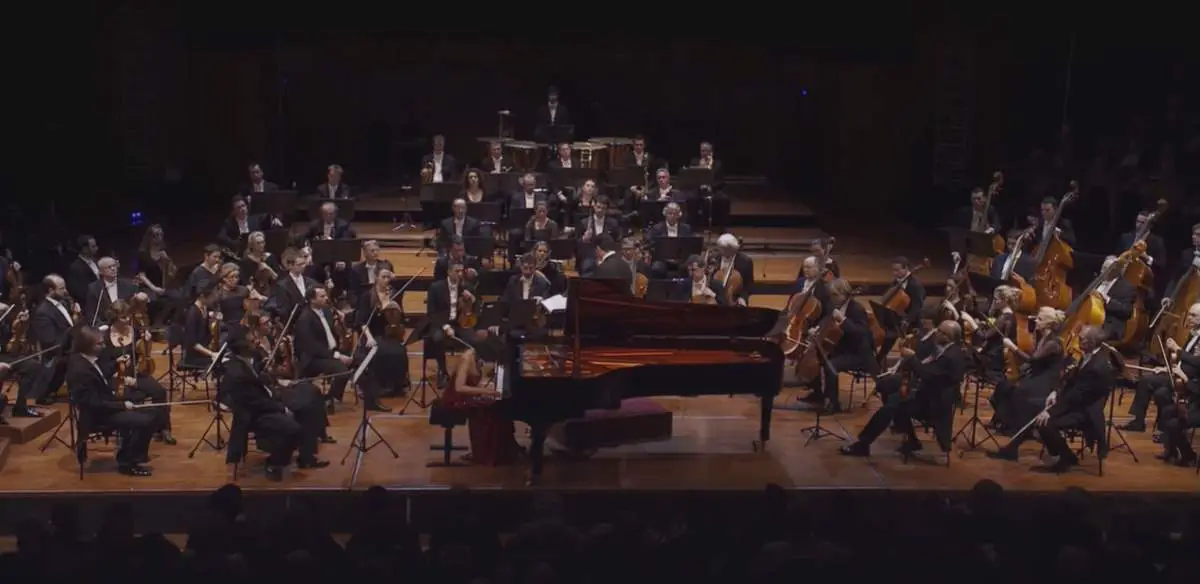Accompanied by the Orchestre National du Capitole de Toulouse, the Georgian classical pianist Khatia Buniatishvili plays Piano Concerto in A minor, Op. 16 by Edvard Grieg. Conductor: Tugan Sokhiev. Composed in 1868, it was the only concerto that the Norwegian composer completed. It is one of Grieg’s most popular works and among the most popular of all piano concerti.
Edward Grieg’s Piano Concerto
The concerto is in three movements:
- Allegro molto moderato (A minor). The first movement is noted for the timpani roll in the first bar that leads to a dramatic piano flourish. The movement is in the Sonata form. The movement finishes with a virtuosic cadenza and a similar flourish as in the beginning.
- Adagio (D-flat major). The second movement is a lyrical movement in D-flat major, which leads directly into the third movement.
- Allegro moderato molto e marcato – Quasi presto – Andante maestoso (A minor – F major – A minor – A major). The finale of Grieg’s piano concerto opens in A minor 4/4 time with an energetic theme (Theme 1), which is followed by a lyrical theme in F major (Theme 2). The movement returns to Theme 1. Following this recapitulation is the 3/4 A major Quasi presto section, which consists of a variation of Theme 1. The movement concludes with the Andante maestoso in A major, which consists of a dramatic rendition of Theme 2 (as opposed to the lyrical fashion in which Theme 2 is introduced).
The work is among Grieg’s earliest important works, written by the 24-year-old composer in 1868 in Søllerød, Denmark, during one of his visits there to benefit from the climate.
Grieg’s piano concerto provides evidence of his interest in Norwegian folk music; the opening flourish is based on the motif of a falling minor second followed by a falling major third, which is typical of the folk music of Grieg’s native country. This specific motif occurs in other works by Grieg, including the String Quartet No. 1. In the last movement of the concerto, similarities to the halling (a Norwegian folk dance) and imitations of the Hardanger fiddle (the Norwegian folk fiddle) have been detected.
The work was premiered by the Norwegian music teacher, pianist, and composer Edmund Neupert (1 April 1842 – 22 June 1888) on 3 April 1869, in Copenhagen, with the Danish conductor and composer Holger Simon Paulli (22 February 1810 – 23 December 1891) conducting. Some sources say that Grieg himself, an excellent pianist, was the intended soloist, but he was unable to attend the premiere owing to commitments with an orchestra in Christiania (now Oslo).
Among those who did attend the premiere were the Danish composer Niels Gade and the Russian pianist Anton Rubinstein, who provided his piano for the occasion. Neupert was also the dedicatee of the second edition of the concerto (Rikard Nordraak was the original dedicatee), and James Huneker said that he composed the first movement cadenza.
The Norwegian premiere in Christiania followed on August 7, 1869, and the piece was later heard in Germany in 1872 and England in 1874. At Grieg’s visit to Franz Liszt in Rome in 1870, Liszt played the notes a prima vista (by sight) before an audience of musicians and gave very good comments on Grieg’s work which would later influence him. The work was first published in Leipzig in 1872, but only after Johan Svendsen intervened on Grieg’s behalf.
The concerto is the first piano concerto ever recorded: it was recorded by pianist Wilhelm Backhaus in 1909. Due to the technology of the time, it was heavily abridged and ran only six minutes.
Grieg revised the work at least seven times, usually in subtle ways, but the revisions amounted to over 300 differences from the original orchestration. In one of these revisions, he undid Liszt’s suggestion to give the second theme of the first movement (as well as the first theme of the second) to the trumpet rather than to the cello. The final version of the concerto was completed only a few weeks before Grieg’s death, and it is this version that has achieved worldwide popularity.
Orchestre National du Capitole de Toulouse

The Orchestre National du Capitole de Toulouse is a French orchestra based in Toulouse. It acts as both a symphony orchestra whose main residence is Toulouse’s Halle aux Grains and the permanent orchestra of the Théâtre du Capitole in Toulouse.
Initially, with the name Orchestre du Capitole de Toulouse, past music directors of the orchestra have included André Cluytens (beginning in 1932) and Georges Prêtre (1951–1955). The Orchestre du Capitole rose to prominence during Michel Plasson’s music director tenure from 1968 to 2003.
Sources
- Piano Concerto (Grieg) on Wikipedia
- Orchestre national du Capitole de Toulouse on Wikipedia


